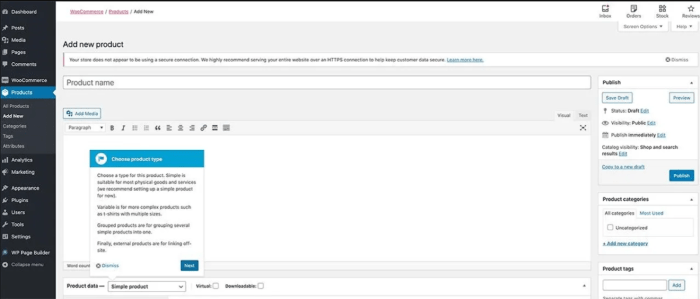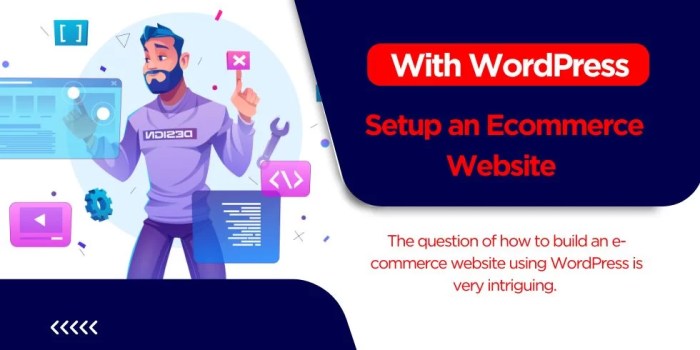Step-by-Step Guide to Set Up a WordPress eCommerce Site – Launching an online store can seem daunting, but with the right guidance, setting up a successful WordPress eCommerce site is achievable. This comprehensive guide provides a detailed, step-by-step process, incorporating best practices and addressing frequently asked questions. We’ll cover everything from choosing the right hosting to optimizing your site for conversions. Let’s dive in!
1. Choosing the Right Hosting and Domain Name
Your foundation is crucial. A reliable hosting provider ensures speed, security, and uptime – essential for a thriving online store. Consider these factors when selecting your hosting:
Choosing a Hosting Provider:
- Performance: Look for providers offering SSD storage and fast loading times. Slow loading speeds lead to high bounce rates.
- Scalability: Choose a plan that can accommodate growth. You’ll need the ability to upgrade easily as your store expands.
- Security: SSL certificates are essential for securing customer data and building trust. Look for providers offering robust security features.
- Support: Reliable customer support is invaluable, especially when troubleshooting issues.
- WordPress Optimization: Some hosting providers offer specialized WordPress hosting, optimized for performance and security.
Popular hosting providers include:
Registering Your Domain Name:
Your domain name is your online address. Choose a name that’s memorable, relevant to your brand, and easy to spell. Many hosting providers offer domain registration as part of their packages. Consider using a domain name registrar like:
2. Installing WordPress
Most hosting providers offer one-click WordPress installation, simplifying the process. If not, follow these steps:
One-Click Installation (Recommended):
Your hosting control panel (cPanel, Plesk, etc.) will have a simple interface to install WordPress with a few clicks. Follow the instructions provided by your hosting provider.
Manual Installation:
If one-click installation isn’t available, you’ll need to download WordPress from wordpress.org , extract the files, and upload them via FTP to your hosting server. This requires some technical knowledge. Refer to your hosting provider’s documentation for specific instructions.

Source: ecomcrew.com
3. Choosing and Installing an eCommerce Plugin
WordPress itself isn’t an eCommerce platform. You’ll need a plugin to add shopping cart functionality. WooCommerce is the most popular choice, offering extensive features and a large community.
Installing WooCommerce:, Step-by-Step Guide to Set Up a WordPress eCommerce Site
- Log in to your WordPress dashboard.
- Navigate to Plugins > Add New.
- Search for “WooCommerce” and click “Install Now.”
- Activate the plugin.
- Follow the WooCommerce setup wizard to configure your store’s settings (currency, location, etc.).
4. Setting Up Your WooCommerce Store: Step-by-Step Guide To Set Up A WordPress ECommerce Site
Once WooCommerce is installed, you’ll need to configure various settings to tailor your store to your specific needs.
Product Management:
Add your products, including detailed descriptions, high-quality images, and pricing. Utilize WooCommerce’s features for managing product variations (sizes, colors, etc.). Consider using a product management system for streamlined inventory.
Payment Gateways:
Integrate payment gateways to process customer transactions. Popular options include:
- PayPal
- Stripe
- Square
Shipping Settings:
Configure your shipping options, including shipping zones, methods, and costs. Consider offering different shipping options to cater to your customers’ needs.
Tax Settings:
Set up your tax settings according to your location and tax laws. WooCommerce provides tools to manage different tax rates and jurisdictions.
5. Choosing a Theme
Your theme determines your store’s look and feel. Choose a theme that is:
- Responsive: Ensures your store looks great on all devices (desktops, tablets, and smartphones).
- WooCommerce Compatible: Ensures seamless integration with your eCommerce plugin.
- -Friendly: Helps improve your search engine rankings.
- Fast Loading: Improves user experience and .
Many free and premium WooCommerce themes are available on platforms like:
6. Optimization
Optimizing your site for search engines is crucial for attracting organic traffic. Consider these aspects:
Research:
Identify relevant s related to your products and services. Use tools like Google Planner, Ahrefs, or SEMrush.
On-Page Optimization:
Optimize your product pages, category pages, and blog posts with relevant s. Use descriptive titles, meta descriptions, and image alt text.
Off-Page Optimization:
Build backlinks from reputable websites to improve your site’s authority and ranking.
7. Marketing Your eCommerce Store
Once your store is live, you need to attract customers. Consider these marketing strategies:
- Social Media Marketing: Promote your products on social media platforms.
- Email Marketing: Build an email list and send newsletters to your subscribers.
- Paid Advertising: Run paid advertising campaigns on Google Ads or social media.
- Content Marketing: Create valuable content (blog posts, articles, etc.) to attract potential customers.
Frequently Asked Questions (FAQs)
- Q: How much does it cost to set up a WordPress eCommerce site? A: The cost varies depending on your hosting, theme, and any additional plugins or services you use. You can start with a budget-friendly option and scale up as your business grows.
- Q: Is WooCommerce easy to use? A: WooCommerce is relatively user-friendly, even for beginners. However, some technical knowledge might be helpful for more advanced customizations.
- Q: How do I add products to my WooCommerce store? A: You can add products through your WordPress dashboard by navigating to Products > Add New. You’ll need to provide details such as product name, description, images, price, and variations.
- Q: How do I accept payments on my WooCommerce store? A: You need to integrate payment gateways like PayPal, Stripe, or Square. WooCommerce supports various payment gateways, and you can choose the ones that best suit your needs.
- Q: How do I handle shipping in WooCommerce? A: WooCommerce provides tools to configure shipping zones, methods, and costs. You can set up different shipping options based on location, weight, and other factors.
Call to Action
Ready to launch your online empire? Follow these steps, and you’ll be well on your way to creating a thriving WordPress eCommerce site. Start building your dream store today!
Q&A
What hosting provider is recommended for WordPress eCommerce?
Several reputable hosting providers excel for WordPress eCommerce, including SiteGround, WP Engine, and Bluehost. The best choice depends on your specific needs and budget.
What are the best WordPress eCommerce plugins?
WooCommerce is the most popular and widely used, offering extensive functionality. Other strong contenders include Easy Digital Downloads (for digital products) and BigCommerce.
How do I choose a suitable theme for my eCommerce site?
Select a theme that is both visually appealing and optimized for eCommerce functionality. Look for themes with responsive design, robust customization options, and good features.

Source: e2developers.com
What are the essential legal aspects of running an eCommerce site?
Familiarize yourself with privacy policies, terms of service, and relevant tax laws in your region. Consider consulting with a legal professional for specific guidance.